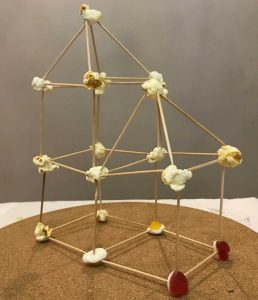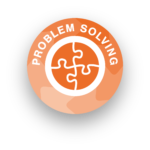2018 is the Year of Engineering, which celebrates the everyday role of engineering through design, building and using structures. Children are never too young to enjoy and learn some of the construction concepts that are so important in the world. Their creativity will flourish through problem-solving and independence. They can even learn simple concepts of force – what makes some constructions stand up while others fall over? Build the activities according to their interests and let their knowledge take them in the direction they choose.
 Squishy and Solid Builds
Squishy and Solid Builds
Materials:
- “Beams”, in the form of dry spaghetti, pretzel sticks, or (for older children) toothpicks
- “Joints”, in the form of popcorn (a few days old is best), marshmallows or jelly cubes.
- A plate to stand the squishy build on.
What can be created by joining the beams with joints? The shapes are endless: triangles, squares, prisms and pyramids. Add a mathematical dimension to the project by building both 2D and 3D shapes. How many corners are there? How strong are the foundations for adding more detail?
After building a tower or other building, balance something on it to find out how much weight it can hold. Would a bigger edifice or smaller tower change the weight distribution?
Discuss testing the constructions, how do they know it works (evidence)? Ask them to explain it with a view to taking their investigations further (analysis, evaluation and planning).
Three Little Pigs House
Suits younger primary aged children – or any age who love a fairy tale!
Materials:
- Cardboard
- Straw
- Sticks
- Masking tape
- A hairdryer
- A pen
First draw the front of a house on cardboard. Cut it out. Draw some pigs looking through the windows.
Ask the student to construct a frame to support the cardboard and keep it upright. For this first frame use lengths of straw, joined with masking tape. At the back of the frame (nowhere else), tape it to the table so it won’t move.
Then become the Big Bad Wolf! Grab the hairdryer and turn it on, on a no-heat setting. Aim it at the house front. Does it fall down? An architect or civil engineer needs to test if their product can withstand the elements!
Rebuild the frame using sticks. Is it better able to resist the wind? If not, suggest how the frame can be strengthened using additional sticks and rigid triangles. The same could be tried with straw. Incorporate real engineering terms into discussions, such as structure, tension, timbers, stress; helping them to develop specialist vocabulary for bigger engineering projects later! For additional extension, simulate a brick house using stones, bricks or similar.
And for the fast-approaching Christmas season:
Festive Lego Maze
Test designing and problem-solving – a simple introduction to motion is a good way to improve patience skills – an essential skill for engineers!
Start with a baseplate, plenty of standard Lego bricks, ideally in festive red and green colours and a marble. Build a low wall around the outside of the baseplate, leaving two holes to make a start and finish hole. Check that the marble isn’t too big to roll through. Build some walls in the middle as obstacles. When the maze is ready, get out a timer to see how long the marble takes to go through. Assess the maze’s performance. How can the maze be changed to make it easier or harder? Try them and see what happens.
Engineering in Action
Discuss why people build particular structures (e.g. skyscrapers are useful in capital cities because they provide maximum living or working space), the new technology needed and how long it takes to build them.
See engineering in action, online or in person at some of these great engineering structures:
Bridges: The Mathematical Bridge (Cambridge), the Bridge of Sighs (Oxford), Clifton Suspension Bridge (Bristol), Twizel Bridge (Northumbria, a medieval stone bridge), Seven Mile Bridge (Florida).
Roads & Railways: York Railway Station, Bristol Temple Meads, Spaghetti Junction (Birmingham).
Water Wheels: Worsbrough Mill (Barnsley), Aberdulais Tin Works and Waterfall (Swansea).
Canals: The Falkirk Wheel (the world’s only rotating boatlift) , Pontcysyllte Aqueduct (Wrexham), Bingley Five Rise Locks (W. Yorkshire).
Non-UK Based Buildings: Sears/Willis Tower, Petronas Towers, Chek Lap Kok airport.









